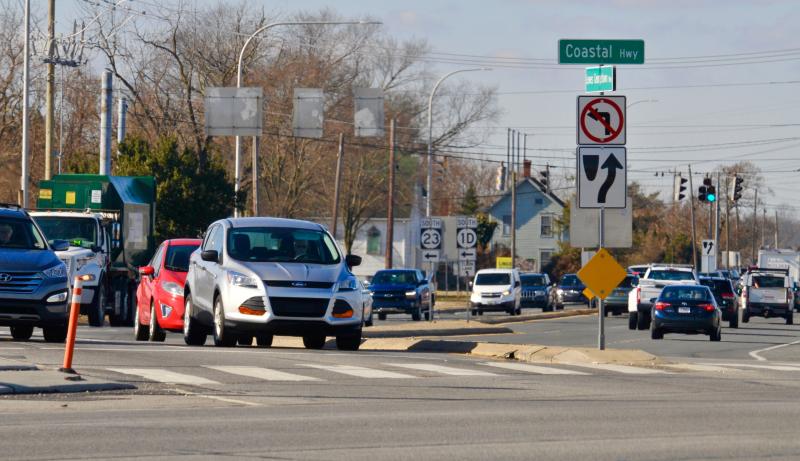Sussex council questions state traffic counts, maps
Never before have Sussex County officials paid so much attention to numbers.
During the writing of the 2018 comprehensive land-use plan, county planning and zoning commissioners questioned population demographics.
Now, in the next phase of the process as county council reviews the draft, members are questioning another set of numbers – Delaware Department of Transportation traffic counts.
As council reviewed the mobility chapter at a Jan. 17 workshop, it didn't take long before Councilman I.G. Burton, R-Lewes, questioned the average daily traffic counts, particularly on Route 1, provided by DelDOT staff and consultants.
Burton said something is wrong if the number of vehicles using Route 1 has increased by only 5,500 – to 65,500 vehicles per day – over the past 10 years.
“Just look at the population growth; the number has to be greater than 5,000. It's incorrect. You can see that from behind the wheel of a car. We need good information to make good land-use decisions,” he said.
Burton also questioned the average annual count on Route 9, from 16,000 vehicles to 16,500 vehicles. “That number is wrong,” he said. “There had to be more than 500 more cars anywhere on Route 9.”
Assistant county attorney Vince Robertson agreed. “The numbers don't pass the eyeball test. This can affect the credibility of the whole plan,” he said.
In addition, council and Robertson questioned the maps in the mobility chapter. “People will know it. The maps don't reflect the traffic they are sitting in,” he said.
“We need the averages during times when people are actually using the roads – between 7 a.m. and 7 p.m.,” Burton said.
DelDOT planning supervisor for Sussex County Josh Thomas said transportation officials could go back to the drawing board and take another look at the numbers. “Looking at the peaks might help,” he said.
During a Jan. 31 workshop, the discussion continued.
Mark Luszcz, DelDOT's chief traffic engineer, said traffic count data is used to show trends and is not the only data used by DelDOT in its decision making.
“There are a lot of factors, but this does not add much value to the process,” Thomas said.
“We are trying to put this science into the plan,” Burton said. “And then I hear you say it's not what you use when making any big decisions.”
“You made a profound statement that none of this data is used in relationship to decisions how you create a new project. I would say the biggest question 220,000 people in Sussex County may have is what does DelDOT do and how do you make a determination to create a new project to offset the growth?” asked Councilman Rob Arlett, R-Frankford.
Luszcz said DelDOT engineers and planners have a process to determine road work based on safety issues such as work done at intersections on Route 9 between Lewes and Georgetown. But, he said, there is no comparable program based on traffic congestion.
“It's not a cut-and-dry process,” Thomas said, adding DelDOT uses a project prioritization model that scores potential projects on a set of data.
He said an explanation of the process could be added to the plan.
Council debated the importance of even including traffic-count data and traffic maps in the comprehensive plan. Council President Mike Vincent, R-Seaford, asked why the information is included if it ends up confusing and misleading officials and residents.
Arlett said the question is not whether the data is relevant but if it's credible and accurate.
Thomas said the information is valuable. “But I'm struggling to get a sense of what we should include that's valuable to you,” he said.
“What we need out of this is how you are making decisions on what we need to do together to make roadways better,” Burton said. “And then how will the land use around the roads affect that decision. Then we need to write a comprehensive plan on a pathway to the solutions we are looking to find.”
Luszcz said data show traffic conditions will be dramatically worse by 2045 without road improvements. “We need to use that information to direct projects and then work together on what projects are needed,” he said. “That's how this document should work.”
“People familiar with an area look at the worst case,” said DelDOT planner Mike DuRoss. “Sussex County has congestion now and possibly will have more congestion in the future. We need to figure out how to convey that.”
Burton said level of service, another key element in the mobility chapter, needs another look. He said maps show the level of service on Routes 9, 54 and 1 will be failing by 2045. “You need to change the date to 2018,” he said. “You tell me the roads are going to fail, but I see that map as 2018.”
Thomas said he would go back to the drawing board to provide more targeted data. “We are not giving you what you need,” he said.
A change in the process
As council reviewed projects included in the 2018 plan, Robertson said some of the same projects – such as work to improve Five Points – were in the 2008 plan. He questioned why no action had been taken.
“What did we not do?” he asked.
It's no secret that Sussex County officials and DelDOT have had a confrontational relationship in the past. And past plans – written by DelDOT staff – have not had much input from county officials.
“We weren't having these conversations,” Thomas replied. “We can't look backward; we have to move forward.”
Thomas said past projects – such as the proposed Western Parkway and dualization of Route 9 – had fallen by the wayside because of lack of support.
He said going forward, DelDOT and Sussex County officials must work together on a united front to reflect priorities for DelDOT and Sussex County officials. “We will go through the process differently based on your goals and objectives,” he said.
Luszcz said in the past the process has been top down, noting DelDOT has failed multiple times on improving the Five Points intersection. “We've failed miserably,” he said.
Thomas said in conjunction with the mobility chapter, DelDOT is creating a long-range transportation plan for Sussex County.
“We want this plan to be used as a tool every day and not left on the table. DelDOT wants to work with you on implementation and build in constant evaluation with annual objectives,” Thomas said.
“There has never been a holistic look at road improvements in Sussex County,” Robertson said. “And there has never been follow-through.”
All chapters – including the mobility chapter – are posted at sussexplan.com for the public to read and comment on.
Road projects outlined in the plan
Major projects – including several grade-separated intersections – outlined in the plan and included in DelDOT's capital transportation program are: Grade-separated intersections with overpasses: Route 1 at Minos Conaway Road, 2020; Route 1 at Route 16, 2021; Route 1 at Route 30, after 2023; Route 1 at Cave Neck Road, after 2023; Route 113 at Route 16, after 2023; Route 113 at Routes 18/404, 2023.
Other projects: Widen Route 24 from Mulberry Knoll Road to Route 1, Lewes, 2018; realign Old Orchard Road to meet Wescoats Corner Road, Lewes, 2020; realign Park Avenue, Route 9 bypass around Georgetown, 2022; and north Millsboro bypass at Route 24, 2023.
In addition, DelDOT has identified future projects in the area:
Intersection and road improvements at Five Points, Lewes, and consider building a connector road for local traffic to link Route 9 and Route 24 west of Lewes. DelDOT has already started a committee to study possible Five Points improvements with a goal of implementing design and construction phases in the capital transportation program in five to 10 years.
High congestion areas identified in the plan:
Route 1 in Milton, Lewes, Reboboth Beach area
Route 26, Route 54 corridors near the coast
Route 113, Georgetown and Millsboro
Route 1 and Route 113 in Milford
Route 13 in the Bridgeville area
Route 9 between Lewes and Georgetown
Route 24 near Millsboro and Rehoboth Beach


















































